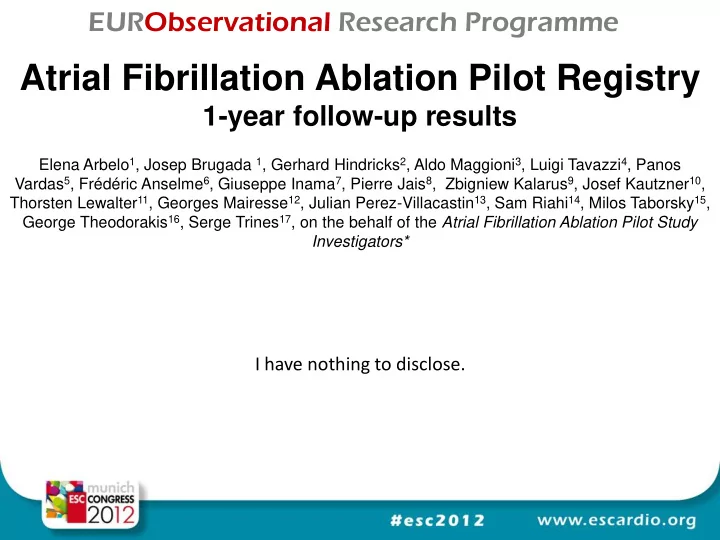

EURObservational Research Programme Atrial Fibrillation Ablation Pilot Registry 1-year follow-up results Elena Arbelo 1 , Josep Brugada 1 , Gerhard Hindricks 2 , Aldo Maggioni 3 , Luigi Tavazzi 4 , Panos Vardas 5 , Frédéric Anselme 6 , Giuseppe Inama 7 , Pierre Jais 8 , Zbigniew Kalarus 9 , Josef Kautzner 10 , Thorsten Lewalter 11 , Georges Mairesse 12 , Julian Perez-Villacastin 13 , Sam Riahi 14 , Milos Taborsky 15 , George Theodorakis 16 , Serge Trines 17 , on the behalf of the Atrial Fibrillation Ablation Pilot Study Investigators* I have nothing to disclose.
Primary endpoint To describe the clinical epidemiology of patients undergoing an AFib ablation procedure, and the diagnostic / therapeutic processes applied in these patients across Europe. EURObservational Research Programme
350 Centres In-Hospital Phase 1410 patients included Centres in 12-month Follow-up Phase Patients In-Hospital Phase 300 19 patients Patients in 12-month Follow-up Phase without ablation 250 1391 patients with ablation Procedure performed 200 1 death during the 150 in-hospital phase 100 1390 patients at discharge 50 90 lost to Follow- up (6.5%) 0 1300 patients at 12 months follow-up
Atrial Fibrillation Ablation Pilot Registry Follow-up status 100 Baseline 90 80 12-month FU 72,3 70 54,9 60 50 41,8 37,6 34,3 40 24,4 30 20 13,7 12,8 13,1 12,6 10,4 6,2 4,8 10 3,8 3,7 3,2 1,1 0,6 0
100 87 At discharge 90 Before 12-month visit 80 After 12-month visit 70 63 60 55 54 50 40 28 30 24 23 22 16 16 20 14 12 10 10 9 9 8 7 10 5 4 3 2 2 1 1 1 0 0 CHADS 2 , % CHADS 2 -Vasc, % 0 53.1 0 48.0 Anticoagulation at 12-m FU according to cardioembolic risk 1 69.0 1 63.3 >1 81.6 >1 76.2
333 patients with at least one 4 deaths at 12-month 944 patients with NO recurrence at 12-month follow-up follow-up recurrence at 12-month 12-MONTH RESULTS after the blanking period (26.1%) (1 included in recurrences) follow-up (73.7%) One-year FAILURE in One-year SUCCESS in 337 patients (26.3%) 944 patients (73.7%) Complications In-hospital phase 12-m follow-up 7.7% 2.6% (major 1.7%) (major 0.8%) Mortality after catether ablation of AFib In-hospital phase, (%) 1 (0.07) Paroxysmal Cardiovascular, % 1( 0.07) AFib Non- paroxysmal AFib p <0.0001 12-month follow-up, (%) 4 (0.31) Cardiovascular, % 2 (0.16) Time of first reported recurrence (days) Non-cardiovascular, % 1 (0.08) Unknown, % 1 (0.08)
Take-home Messages There are obvious differences in patient characteristics between patients undergoing an AFib catheter ablation to the overall population suffering from AFib: they are younger with paroxysmal AFib with no underlying heart disease. Only a third were women. The indication for the ablation was symptoms in almost 90% of patients. However, up to a third of the population also wanted a drug-free life-style. The procedure was considered successful in 74% of patients, meaning no documented arrhythmias after a 3-month blanking period. However, 32% of all patients were still taking antiarrhythmic drugs. Complications during the first year after the ablation were infrequent (2.6%), and mainly related to cerebrovascular events (0.54%) or vascular injuries (0.71%). However, the peri-operative complication rate is not negligible (7.7% of which, 1.7% was major) and must be weighed. There is clearly a gap between recommendations and the actual clinical practice that should be considered in the future (anticoagulation and antiarrhythmic medication management, type and frequency of follow-up, arrhythmia recurrence-documentation methodology, etc.).
Recommend
More recommend